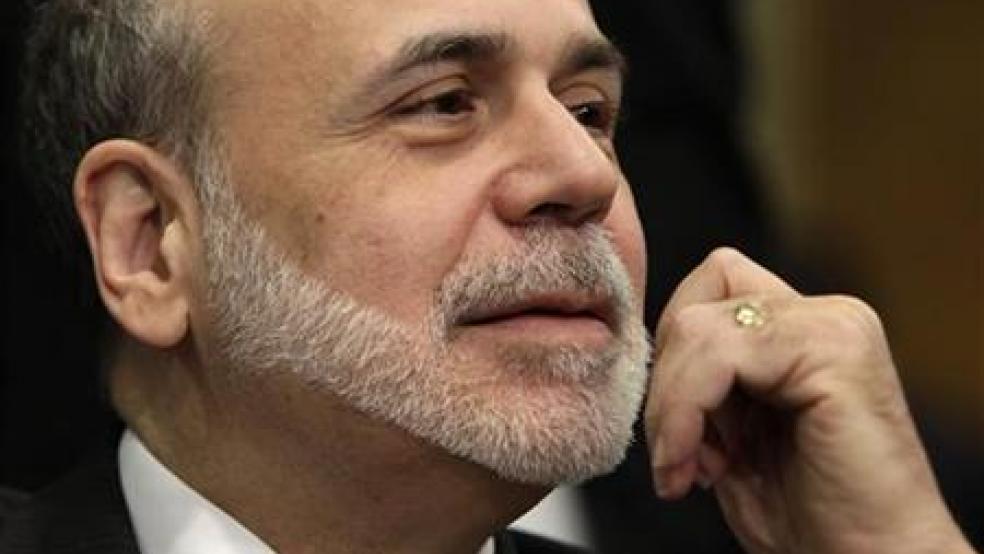WASHINGTON (Reuters) - Federal Reserve Chairman Ben Bernanke on Wednesday said U.S. monetary policy was "more or less in the right place" even though the central bank would not hesitate to launch another round of bond purchases if the economy were to weaken.
In a statement after a two-day meeting, the Fed's policy-setting panel reiterated its expectation that interest rates would not rise until late 2014 at the earliest, and it took no action on monetary policy.
The Fed also adjusted its economic forecasts to acknowledge an improving labor market and slightly higher inflation over the next few years. The revised forecast, along with a change of heart by the most dovish Fed officials on the timing of the first rate rise, suggested the central bank has grown somewhat less inclined to take more action to help the economic recovery.
"We remain entirely prepared to take additional balance sheet actions as necessary to achieve our objectives," Bernanke told reporters. "Those tools remained very much on the table and we would not hesitate to use them should the economy require that additional support."
But he added: "For the time being, it appears that we are more or less in the right place.
In response to the deepest recession in generations, the Fed cut overnight rates to near zero in December 2008 and more than tripled its balance sheet by purchasing $2.3 trillion in government and mortgage bonds in two rounds of so-called quantitative easing.
Bernanke said the central bank could be spurred into doing more if the U.S. unemployment rate, which stood at 8.2 percent last month, failed to keep moving lower.
Fresh projections released by the central bank showed the most dovish officials no longer want to put off a rate increase until 2016. The Fed said seven officials believe it would be appropriate to raise borrowing costs in 2014, up from five officials in January, while only four wanted to wait longer, down from six.
Interest-rate futures showed traders now betting the first rate hike would come in March 2014, a month sooner than earlier thought.
"It looks like the more positive data over the past few months has affected the people at the more dovish end of the spectrum," said Sean Incremona, an economist at 4Cast in New York.
Colin Lundgren, head of fixed income at Columbia Management in Minneapolis, said: "I wouldn't call it hawkish. It's more that they are less dovish."
A poll of 12 big Wall Street bond dealers put chances of a further easing of monetary policy at just 28 percent. Separately, economists at Nomura, which had previously expected the Fed to buy more bonds, said they now anticipated no action.
Prices for long-term U.S. government debt ended slightly lower as investors pulled back bets on further bond buying. Stocks closed higher as a near doubling of profits at Apple fueled optimism.
Richmond Fed President Jeffrey Lacker, who is known for his hawkish stance on inflation, dissented against the central bank's policy decision, saying he believed rates would need to rise sooner than late 2014. He has now dissented at all three of the policy meetings the Fed has held this year.
INFLATION SPIKE SEEN TEMPORARY
U.S. economic growth has been just firm enough to weaken the case for additional stimulus through Fed bond purchases. Gross domestic product expanded at a 3 percent annual rate in the fourth quarter but economists expect that it slowed to around a 2.5 percent pace in the first three months of this year.
The Commerce Department will provide its initial reading on first-quarter GDP on Friday.
The Fed described the economy as expanding moderately, just as it did last month, and noted that the unemployment rate had declined but remains elevated. In March it had said the jobless rate had declined "notably."
The central bank bumped up its growth forecast for 2012 but lowered it for the next two years. The forecast showed the central bank expects the jobless rate to fall faster than it did previously.
It also sees inflation higher over the next few years than it saw in January, with a notable rise in its forecasts for this year that takes into account a run-up in gasoline prices.
Still, the Fed does not expect inflation to breach its 2 percent target.
Policymakers nodded to "some signs of improvement" in the housing sector and, while repeating that they expect moderate economic growth in coming quarters, said the recovery should then "pick up gradually."
"To support a stronger economic recovery and to help ensure that inflation, over time, is at the rate most consistent with its dual mandate, the committee expects to maintain a highly accommodative stance for monetary policy," the Fed said.
As officials gathered, the government reported that orders for long-lasting manufactured goods plunged 4.2 percent in March, the biggest drop since the economy was nose-diving in early 2009. The data was the latest to suggest the economy lost momentum as the first quarter drew to a close.
(Writing by Jonathan Spicer; Editing by Andrea Ricci, Tim Ahmann, Leslie Adler)


